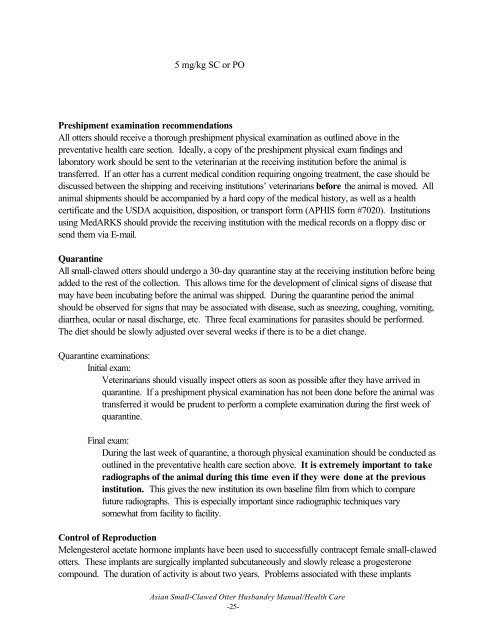Asian Small-Clawed Otter Husbandry Manual (1998)
Asian Small-Clawed Otter Husbandry Manual (1998)
Asian Small-Clawed Otter Husbandry Manual (1998)
Create successful ePaper yourself
Turn your PDF publications into a flip-book with our unique Google optimized e-Paper software.
5 mg/kg SC or POPreshipment examination recommendationsAll otters should receive a thorough preshipment physical examination as outlined above in thepreventative health care section. Ideally, a copy of the preshipment physical exam findings andlaboratory work should be sent to the veterinarian at the receiving institution before the animal istransferred. If an otter has a current medical condition requiring ongoing treatment, the case should bediscussed between the shipping and receiving institutions’ veterinarians before the animal is moved. Allanimal shipments should be accompanied by a hard copy of the medical history, as well as a healthcertificate and the USDA acquisition, disposition, or transport form (APHIS form #7020). Institutionsusing MedARKS should provide the receiving institution with the medical records on a floppy disc orsend them via E-mail.QuarantineAll small-clawed otters should undergo a 30-day quarantine stay at the receiving institution before beingadded to the rest of the collection. This allows time for the development of clinical signs of disease thatmay have been incubating before the animal was shipped. During the quarantine period the animalshould be observed for signs that may be associated with disease, such as sneezing, coughing, vomiting,diarrhea, ocular or nasal discharge, etc. Three fecal examinations for parasites should be performed.The diet should be slowly adjusted over several weeks if there is to be a diet change.Quarantine examinations:Initial exam:Veterinarians should visually inspect otters as soon as possible after they have arrived inquarantine. If a preshipment physical examination has not been done before the animal wastransferred it would be prudent to perform a complete examination during the first week ofquarantine.Final exam:During the last week of quarantine, a thorough physical examination should be conducted asoutlined in the preventative health care section above. It is extremely important to takeradiographs of the animal during this time even if they were done at the previousinstitution. This gives the new institution its own baseline film from which to comparefuture radiographs. This is especially important since radiographic techniques varysomewhat from facility to facility.Control of ReproductionMelengesterol acetate hormone implants have been used to successfully contracept female small-clawedotters. These implants are surgically implanted subcutaneously and slowly release a progesteronecompound. The duration of activity is about two years. Problems associated with these implants<strong>Asian</strong> <strong>Small</strong>-<strong>Clawed</strong> <strong>Otter</strong> <strong>Husbandry</strong> <strong>Manual</strong>/Health Care-25-
















